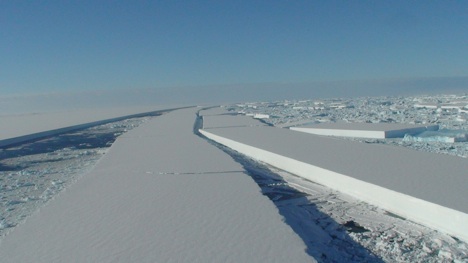Guest post by Steven Goddard
What is Wrong with this Picture?
The picture of the Wilkins Ice Shelf cracks is itself fine, and the news media loves it so much that they recycle it every year. The problem is with the interpretation which some people continue to insist on that the ice is “melting.”
A picture is worth a thousand words, so below are a few showing what melting ice actually looks like:

Melting Arctic Ice click for larger image
Astute WUWT readers may recall seeing the photo above flashed around the world with captions such as “polar bears stranded” on an ice cube at sea. In one case a story even went so far as to suggest they drowned, with no facts to back up the claim. It turns out the “credited” photographer to be a fabrication, and exploitation, please follow this link to the original photographer, Amanda Byrd. See the bottom right photo.
The image was copied from the ships computer (where Byrd had downloaded the camera flash memory stick to) by another member of the shipboard research crew ( Dan Crosbie) and passed on to Environment Canada. Then it was eagerly adopted by many as an example of the fate that awaits the polar bears - including Al Gore, who used the picture as huge projected backdrop in one of his highly lucrative lectures, a conference of human resource executives on March 22, 2007 in Toronto, Canada.
Gore said:
“Their habitat is melting,” “beautiful animals, literally being forced off the planet.”
Audience: [gasp!]
Yes, it melts every summer.
Melting ice is dark, corroded, irregular, wet, thin and rough. Yet the Wilkins picture shows none of those features. The cracked Wilkins Ice is bright, smooth, dry - and has sharp, clean fractures at 90 degree angles to the surface. Nothing in that picture even remotely hints at melting. The interstitial sea water is very cold and is quickly refreezing in the cracks.
NSIDC’s Ted Scambos has proposed a mechanism for ice sheet breakup, where pooling water on the surface seeps down into small cracks in the ice and causes fracturing as the water refreezes.
However, there is no evidence of pooling water on the surface in the Wilkins image above, and it does not sound plausible as a mechanism for making a clean crack 200 metres thick and miles long.
A generally pro-AGW 2005 paper published by the University of Chicago may shed some light on what is really going on with the ice shelves. Ice shelf retreat is cyclical, normal, has little long-term effect, and may happen faster in the winter. What does that have to do with CO2?
Historical records show that large tabular bergs are produced sporadically with typical recurrence times of 50-100 years [Budd, 1966] and despite their large size, appear to have little effect on the long-term ice flow. Unlike the disintegration of parts of the peninsular ice shelves, the production of tabular bergs is part of a normal cycle in which the ice shelf advances beyond its confining embaymentor pinning points and subsequently retreats by calving.
….
Despite this prominent role we know very little about the mechanisms and controlling forces that lead to rift initiation and propagation. This ignorance hinders any attempt to assess accurately how ice sheets will respond to future climate change.
…..
However, two of the three bursts did occur within three days of periods of sustained winds (shaded part of Figure 2c), suggesting there might be some relationship with prolonged winds. If this were the case, we would expect the rift would propagate faster in the winter when the winds are strongest
Note the authors’ usage of ”Unlike the disintegration of parts of the peninsular ice shelves” in the first paragraph. Why does ice on the Antarctic Peninsula behave differently? Perhaps it has become an AGW sacred cow. It is the only place on the continent behaving according to expectations.
The excess area of Antarctic ice is enough to contain more than five Floridas.
Note that the positive ice anomaly is greater now than it was any time prior to 1995. However, in 1980 the anomaly was nearly 3,000,000 km2 squared lower - i.e. there was enough ice loss in 1980 (relative to the present) to contain about one third of Europe. Sea ice and cold go hand in hand. Perhaps we need a new term for Antarctic cooling deniers?
Something like “Ozone Holers.”




No comments:
Post a Comment